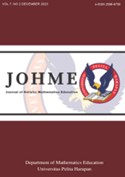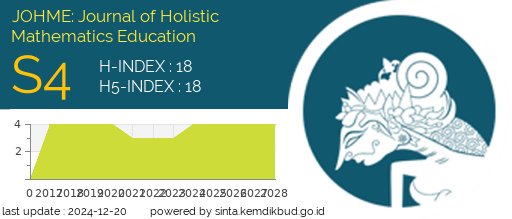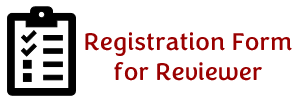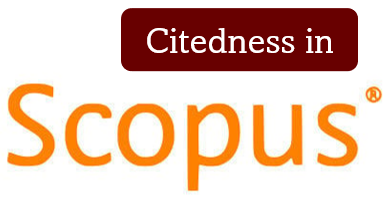PENGEMBANGAN APLIKASI SMART - CALCULATOR BERBASIS DIGITAL SEBAGAI MEDIA PEMBELAJARAN MATERI KOMBINATORIKA [DEVELOPING SMART APPLICATION - DIGITAL-BASED CALCULATOR AS A REINFORCEMENT MEDIA IN LEARNING DISCRETE MATHEMATICS]
DOI:
https://doi.org/10.19166/johme.v7i2.7450Schlagworte:
discrete mathematics, combinatorica, smart calculator, matematika diskrit, kombinatorika, kalkulator pintarAbstract
Learning combinatorics material requires a digital learning medium that is able to support students' independent learning. The unavailability of digital media makes students experience difficulties, so independent learning cannot be carried out effectively. This research aims to develop a digital-based smart calculator application as a learning medium for combinatorics material that meets the criteria of being valid, effective, and practical. This research applies research and development (R&D) methods whose stages are the preliminary stage, planning stage, formative evaluation stage, prototyping stage, and large class trials (field tests). A total of 31 Bangka Belitung State Manufacturing Polytechnic TRPL students were the subjects of this research. The data collection techniques applied are expert validation sheets, effectiveness trial questionnaires, and practicality trial questionnaires. Expert validation activities provide evidence that the media is valid and ready to be used in learning. Based on effectiveness and practicality trials on 31 students, the results showed that the digital-based smart calculator application was classified as effective and practical. Based on the research conducted, it can be concluded that the development of a digital-based smart-calculator application is valid, effective, and practical, so that the digital-based smart-calculator application is ready to be used and applied to learning combinatorics material.
BAHASA INDONESIA ABSTRACT: Pembelajaran materi kombinatorika membutuhkan suatu media pembelajaran digital yang mampu mendukung pembelajaran mandiri mahasiswa. Tidak tersedianya media digital ini membuat mahasiswa mengalami kesulitan sehingga pembelajaran mandiri tidak dapat terlaksana dengan efektif. Penelitian ini bertujuan untuk mengembangkan aplikasi smart - calculator berbasis digital sebagai media pembelajaran materi kombinatorika yang memenuhi kriteria valid, efektif, dan praktis Penelitian ini menerapkan metode penelitian dan pengembangan (R&D) yang tahapannya yaitu tahap preliminary, tahap perencanaan, tahap formative evaluation, tahap prototyping, dan uji coba kelas besar (field test). Sejumlah 31 mahasiswa TRPL Politeknik Manufaktur Negeri Bangka Belitung menjadi subjek dalam penelitian ini. Teknis pengumpulan data yang diterapkan adalah menggunakan lembar validasi ahli, angket uji coba keefektifan, dan angket uji coba kepraktisan. Kegiatan validasi ahli memberikan hasil bahwa media valid dan siap digunakan dalam pembelajaran. Berdasarkan uji coba keefektifan dan kepraktisan terhadap 31 mahasiswa memberikan hasil bahwa aplikasi smart - calculator berbasis digital tergolong efektif dan praktis. Berdasarkan penelitian yang dilakukan dapat disimpulkan bahwa pengembangan aplikasi smart - calculator berbasis digital tergolong valid, efektif, dan praktis sehingga aplikasi smart - calculator berbasis digital siap digunakan dan diterapkan pada pembelajaran materi kombinatorika.
Literaturhinweise
Anwar, M. S., Ningsih, E. F., Triana, D., & Maseleno, A. (2019). Developing an interactive mathematics multimedia learning based on ispring presenter in increasing in learning mathematics. Al-Jabar: Jurnal Pendidikan Matematika, 10(1), 135-150. https://doi.org/10.24042/ajpm.v10i1.4445
Arikarani, Y., & Amirudin, M. F. (2021). Pemanfaatan media dan teknologi digital dalam mengatasi masalah pembelajaran di masa pandemi. STAI Bumi Silampari, 4(1), 93-116. https://doi.org/10.37092/ej.v4i1.296
Astuti, R. (2017). Analisis learning obstacles mahasiswa dalam mempelajari materi kombinatorial. Jurnal Edumath, 3(1), 56-64. https://doi.org/10.52657/je.v3i1.284
Drigas, A. S., & Pappas, M. A. (2015). A review learning aplications for mathematics. International Journal of Interactive Mobile Technologies, 9(3), 18-23. https://doi.org/10.3991/ijim.v9i3.4420
Fadli, R., Sartono, N., & Suryanda, A. (2017). Pengembangan kamus berbasis sistem operasi telepon pintar pada materi biologi SMA kelas XI. Jurnal Pendidikan Matematika dan IPA, 8(2), 10-17. http://dx.doi.org/10.26418/jpmipa.v8i2.21171
Florayu, B., Isnaini, M., & Testiana, G. (2017). Pengaruh penggunaan media pembelajaran komik terhadap peningkatan hasil belajar matematika siswa Kelas VII di sekolah menengah pertama negeri 10 palembang. Jurnal Pendidikan Matematika, 6(1), 45-56. https://doi.org/10.31980/mosharafa.v6i1.293
Hafidz, M., & Masriyah, M. (2020). Pengembangan media pembelajaran berbasis android untuk pembelajaran permutasi dan kombinasi. Kreano: Jurnal Matematika Kreatif Inovatif, 11(2), 126-135. https://doi.org/10.15294/kreano.v11i2.24198
Hanafi. (2017). Konsep penelitian R&D dalam bidang pendidikan. Saintifika Islamica: Jurnal Kajian Keislaman, 4(2), 129-150. Retrieved from https://jurnal.uinbanten.ac.id/index.php/saintifikaislamica/article/view/1204/953
Hariyono, M., & Widhi, E. N. (2021). Geoshape digital: Media pembelajaran dalam meningkatkan pemahaman konsep matematika SD. Jurnal Ilmiah Pendidikan Dasar, 8(1), 35-50. http://dx.doi.org/10.30659/pendas.8.1.35-50
Hudson, P. (2013). Learning to teach in the primary school. Cambridge, UK: Cambridge University Press.
Kaensige, A. L., & Yohansa, M. (2018). Penggunaan aplikasi class123 sebagai upaya meningkatkan keterlibatan perilaku siswa kelas XII IPA di suatu SMA di kota Tangerang. JOHME: Journal of Holistic Mathematics Education, 2(1), 57-70. https://doi.org/10.19166/johme.v2i1.940
Meidasari, V. E. (2016). Using of digital media to enchance teaching and learning english on the well-being of Indonesian students. Journal of English Language & Culture, 6(1), 76-86. Retrieved from https://journal.ubm.ac.id/index.php/english-language-culture/article/view/274/264
Miftah, M., & Rokhman, N. (2022). Kriteria pemilihan dan prinsip pemanfaatan media pembelajaran berbasis TIK sesuai kebutuhan peserta didik. Educenter: Jurnal Ilmiah Pendidikan, 1(4), 412- 420. https://doi.org/10.55904/educenter.v1i4.92
Nusyirwan, D., Lingga, S., & Perdana, P. P. (2020). Rancang bangun smart book calculator berbasis mikrokontroller arduino uno sebagai inovasi cerdas untuk memudahkan siswa menghitung guna menuju revolusi industri 4.0. Jurnal Teknologi dan Terapan Bisnis (JTTB), 3(1), 13-22. https://doi.org/10.0301/jttb.v3i1.119
Pratiwi, I. R., & Silalahi, P. (2021). Pengembangan media pembelajaran matematika model blended learning berbasis moodle. Aksioma: Jurnal Program Studi Pendidikan Matematika, 10(1), 206-218. http://dx.doi.org/10.24127/ajpm.v10i1.3240
Pratiwi, I. R., Krishnaningsih, S. D., & Sari, E. M. (2022). Pengembangan soal matematika bilingual berbasis mathematical literacy dengan konteks teknik mesin untuk mahasiswa politeknik. Aksioma: Jurnal Program Studdi Pendidikan Matematika, 11(4), 3609-3623. http://dx.doi.org/10.24127/ajpm.v11i4.6136
Pumptow, M., & Brahm, T. (2021). Students' digital media self efficacy and its importance for higher education institutions: Development and validation of a survey instrument. Technology, Knowledge and Learning, 26, 555-575. https://doi.org/10.1007/s10758-020-09463-5
Rofiqoh, I., Puspasari, D., & Zulinda, N. (2020). Pengembangan game math space adventure sebagai media pembelajaran pada materi pecahan di sekolah dasar. Lantera Sriwijaya: Jurnal Ilmiah Pendidikan Matematika, 2(1), 41-54. https://doi.org/10.36706/jls.v2i1.11445
Saha, R. A., Ayub, A. F., & Tarmizi, R. A. (2010). The effect of Geogebra on mathematics achievement: Enlightening coordinate geometry learning. Procedia: Social and Behavioral Sciences, 8, 686- 693. https://doi.org/10.1016/j.sbspro.2010.12.095
Setiawan, T. Y., Yunita, H., Sirait, L. M., Qodriati, A., & Gusrianti, R. (2023). The use of online media in mathematics learning in elementary schools. International Social Sciences and Humanities, 2(1), 295-299. https://doi.org/10.32528/issh.v2i1.128
Sukoriyanto, Nusantara, T., Subanji, & Chandra, T. (2016). Student' error in solving the permutation and combination problems based on problem solving steps of Polya. Canadian Center of Science and Education, 9(2), 11-16. https://doi.org/10.5539/ies.v9n2p11
Tamam, B., & Dasari, D. (2021). The use of geogebra software in teaching mathematics. Jurnal of Physics: Conference Series, 1882, 1-6. https://doi.org/10.1088/1742-6596/1882/1/012042
Ulia, N. (2018). Efektivitas collaborative learning berbantuan media short card berbasis IT terhadap pemahaman konsep matematika. Jurnal Ilmiah Pendidikan Dasar, 3(2), 1-11. http://dx.doi.org/10.30659/pendas.3.2.1-11
Zulkardi. (2002). Developing a learning of realistic mathematics education for Indonesian students teachers. Retrieved from https://repository.unsri.ac.id/871/1/thesis_Zulkardi.pdf
Downloads
Veröffentlicht
Zitationsvorschlag
Ausgabe
Rubrik
Lizenz
Authors who publish with this journal agree to the following terms:
1) Authors retain copyright and grant the journal right of first publication with the work simultaneously licensed under a Creative Commons Attribution License (CC-BY-SA 4.0) that allows others to share the work with an acknowledgement of the work's authorship and initial publication in this journal.
2) Authors are able to enter into separate, additional contractual arrangements for the non-exclusive distribution of the journal's published version of the work (e.g., post it to an institutional repository or publish it in a book), with an acknowledgement of its initial publication in this journal.
3) Authors are permitted and encouraged to post their work online (e.g., in institutional repositories or on their website). The final published PDF should be used and bibliographic details that credit the publication in this journal should be included.”










